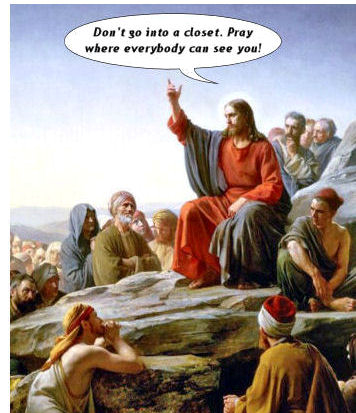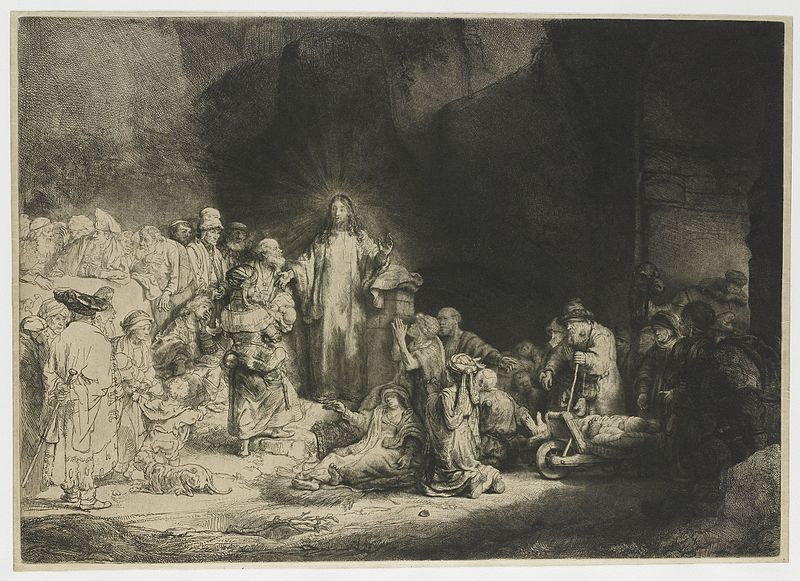
“Christ cleansing a leper…”
On May 12 the AP published Study reveals Americans are less Christian than ever. The gist of the article was that a recent poll found that Christianity is on the decline, but that lots more people being polled are checking “another box.” That other poll-box was “nones,” or “no religion:”
The number of Americans who don’t affiliate with a particular religion has grown to 56 million in recent years, making … “nones” the second-largest in total numbers behind evangelicals, according to a Pew Research Center study…
Which raises the question: Why? On that topic, I have a few thoughts…
For starters, check out The Blog link at the top of this page. That’s where I wrote that one thing I’m trying to do here is “reach out to Nones and others turned off by ‘negative Christians.'” And as to the why of those turned off by some of the current Christianity:
[T]he single most important reason for the rise of the unknowns [“Nones”] is that combination of the younger people moving to the left on social issues and the most visible religious leaders moving to the right on that same issue.
Those “visible leaders” include far-right politicians who wear their religion on their sleeves. There’s an example in the photo-caption in “less Christian than ever;” a man holding rosary beads in Baton Rouge, as “Louisiana Gov. Bobby Jindal continued to court Christian conservatives for a possible presidential campaign…”
 Here’s the problem: both those right-wing politicians and the voters they court are seen as negative by most other Americans. You don’t believe it? Just Google “negative Christians.” I did that and got almost 12 million results. (As noted in The Blog.)
Here’s the problem: both those right-wing politicians and the voters they court are seen as negative by most other Americans. You don’t believe it? Just Google “negative Christians.” I did that and got almost 12 million results. (As noted in The Blog.)
And that seems to be a big reason so many younger Americans are turning away from mainstream Christianity. There’s a general but widespread perception – especially among the young Americans who “really are our future” – that way too many older Christians especially are just way too negative.
Put another way, it’s hard to imagine one of today’s older far-right conservatives ever coming near a leper, let alone touching or healing one. But that’s what Jesus did in Matthew 8 (1-4), Mark 1 (40-45), and Luke 5 (12-16), and shown in the top painting. In the same way it’s equally hard to imagine Jesus ever saying “There’s No Such Thing As A Liberal Christian.”
For more on that topic, just Google “rick santorum liberals not real Christians.” But take note: Such a search should also lead you to Liberal media shamelessly twists comment from Rick Santorum. Which is of course a distinct possibility, though I’d add that reporters in general seem to be equal opportunity “lazy cusses.” That’s what Harry Truman – a devout Democrat himself – said about reporters in general. Then there was that quote from Joe Namath:
Shortly after Joe signed with the Jets (for a record salary), a wise-guy New York reporter asked what he had majored in, down south at the University of Alabama; “Basket-weaving?” Joe answered, “No man, I majored in journalism. It was easier.”
See Harry Truman and the next election and “Gone Girl” movie review and Media Frenzy.
But be that as it may…
That is: “Be that as it may,” there’s still the widespread perception in the American public at large that too many Christians are too negative and too close-minded. (See the notes.)
For another example, try this. Start typing “holier” in your search engine. “Holier than thou” will automatically pop up. (There’s probably an object lesson there: an “example from real life that teaches a lesson or explains something.”) Then too, a “holier than thou” search will lead to Self-righteousness – Wikipedia, the free encyclopedia.
The article defined self-righteousness as a feeling or display (usually smug) of moral superiority, “derived from a sense that one’s beliefs, actions, or affiliations are of greater virtue than those of the average person. Self-righteous individuals are often intolerant of the opinions and behaviors of others.” Wikipedia said the term is usually derogatory; “self-righteous individuals are often thought to exhibit hypocrisy.” On that note see Molly Ivins June 29:
When it comes to religion, I’ve always believed it’s more important to walk the walk than to talk the talk. I come from a tradition (Episcopal) that considers it rather in bad taste to wear your religion on your sleeve…
 In a sense I couldn’t have said it better myself.
In a sense I couldn’t have said it better myself.
But see also my post On praying in public. That post – like Molly’s – cited Jesus in Matthew 6 (verses 5 and 6), “whenever you pray, do not be like the hypocrites; for they love to stand and pray in the synagogues and at the street corners, so that they may be seen by others… But whenever you pray, go into your room and shut the door and pray to your Father who is in secret; and your Father who sees in secret will reward you.” (As ironically illustrated at right.)
Which leads right in to Matthew 6 (verses 16 to 18), “And whenever you fast, do not look dismal, like the hypocrites, for they disfigure their faces so as to show others that they are fasting… But when you fast, [do] so that your fasting may be seen not by others but by your Father who is in secret; and your Father who sees in secret will reward you.”
Which is another way of saying that religious hypocrisy had been around for a long, long time. And that brings up another thing Molly Ivins said better than I could ever hope to:
I long ago learned to shy away from the stink of sanctimony. We are all familiar with pietistic hypocrites and spiritual humbugs wearing dog collars. I doubt the clergy is more afflicted with canting Pharisees than the legal profession is with sleazy chiselers, but neither type is exactly rare… When you throw politics into the religious mix, or vice versa, you get some real beauts in the hypocrisy department.
And that’s a cross that all Christians have to bear… (Which raises anew the question: “Should I wear my religion on my sleeve?” The quick and pragmatic answer would be: “Not if if drives away the very ‘converts’ that you’re trying to reach out to!“)
And speaking of “reaching out,” we come to Rembrandt’s “Hundred Guilder Print:”
It is also called Christ healing the sick,Christ with the Sick around Him, Receiving Little Children, or Christ preaching, since the print depicts multiple events from Matthew 19, including Christ healing the sick, debating with scholars and calling on children to come to him. The rich young man mentioned in the chapter is leaving through the gateway [at] right.
Note that Jesus is opening His arms – reaching out – welcoming those around Him.
Note also that Jesus doesn’t seem to be saying – to the crowd of unwashed – “Excuse me, I have to find out if you’re a liberal – or other ‘untouchable‘ – before I can welcome you in…”

The upper image is courtesy of Jesus cleansing a leper – Wikipedia. The full caption: “Christ cleansing a leper by Jean-Marie Melchior Doze, 1864.” Note also that in this post I borrowed “liberally” from two prior posts, On “holier than thou”, and On Jesus: Liberal or Fundamentalist?
The “stop” image is courtesy of Christianity’s Image Problem – TIME. Other posts from 2007 included Study: Christianity No Longer Looks Like Jesus, and A New Generation Expresses its Skepticism and Frustration with Christianity. The latter included these observations:
Among young non-Christians, nine out of the top 12 perceptions were negative. Common negative perceptions include that present-day Christianity is judgmental (87%), hypocritical (85%), old-fashioned (78%), and too involved in politics (75%) – representing large proportions of young outsiders who attach these negative labels to Christians. (E.A.)
(Apparently 2007 was a really bad year for “perceived Christianity…”)
The “ironic Jesus” image was borrowed from On praying in public.
The bottom image is courtesy of Rembrandt The Hundred Guilder Print.jpg – Wikimedia Commons. See also the top image in On praying in public, and Wikipedia.
Re: “Nones.” In other posts I cited “Nones” on the Rise and Losing Our Religion: The Growth Of The “Nones.” These were about the rise of fellow Americans – and especially younger Americans – who seem to overwhelmingly think that religious organizations are “too concerned with money and power, too focused on rules and too involved in politics.” As to the term “fellow Americans:” That was one of Richard Nixon’s favorite phrases that’s been burned into my memory from long ago. He first used it famously in his 1952 Checkers speech. He continued using that favorite phrase until Aug 08, 1974, when he resigned as President of the United States after Watergate.